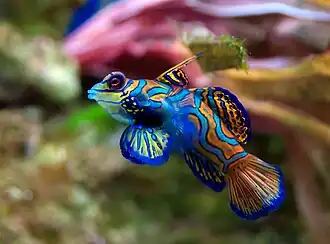Aquaria/Reefkeeping
.jpg)
Reefkeeping, or reef-keeping and sometimes reef keeping, is a marine aquarist hobby of creating, maintaining, and actively sustaining a living captive reef, within an aquarium, complete with various life forms common to coral or other types of reefs.
Introduction

"An aquarium (plural aquariums or aquaria) is a clear-sided container in which water-dwelling plants and animals (usually fish, and sometimes invertebrates, as well as amphibians, marine mammals, and reptiles) are kept in captivity, often for public display; or it is an establishment featuring such displays."[1]
Audience
Scope
Science of Reefkeeping
In Nature
Physics
Light
Two light levels: photosynthetically active radiation (PAR, ~400-700 nm), PAR of 80 versus 180 µmol m-2 s-1 have been used to grow "crustose coralline algae (CCA), a desired group of benthic calcifying algae", on two "types of rock (initially bare coral rock and rock preconditioned for 12 weeks under low light)".[2]
"In general, pink CCA's developed more quickly than red CCA's, with 4.31-10.44% versus 2.45-4.56% cover after 9 weeks, respectively. Pink CCA grew more quickly on non-preconditioned rock; after 9 weeks of culture, pink CCA showed higher percentage cover and larger colony size on initially bare rock compared to preconditioned rock. In contrast, red CCA showed higher percentage cover and colony density on preconditioned rock. Although higher pink and red CCA colony densities were found at higher light intensity, no effect of irradiance was found on relative CCA cover. In addition, red CCA colony size was larger at the lowest irradiance, for both rock types."[2]
Temperature
Water Motion
Chemistry
Salt
Trace Elements
Nutrients
Biology
Food
Ecology
Physiology
Microlife
Bacteria
Plankton
Algae
Invertebrates
Cnidaria
Echinodermata
Crustaceans
Vertebrates
Fish
The Aquarium
Introduction
Chemistry
Nitrogen
Phosphate
Calcium
Trace Elements
Physics
Light
Temperature
Water Motion
Ethics
Practical Reefkeeping
Introduction
General Rules
Equipment
Introduction
Materials
Glass
Wood
Sillicone
Plastics
Rubber
Coatings
Metal
Blacklisted
Ftalates
Metals
Tank
Stand
Sump
Plumbing
Lighting
Fluorescent
Metal Halide
LED
Water Movement
Pumps
Wavemakers
Dump
Temperature Control
Heating
Cooling
Filtering
Mechanical
Biological
Materials
Additives
Kalkwasser
Sterilization
UV
Ozone
Analysis
Introduction
Test Kits
pH
Nitrates
Phosphates
Calcium
Continuous
pH
Conductivity
Light
RedOx
Electronics
Timers
Safety
Other
Food Dispenser
Getting Started
Planning
Types
Fish Only
Nano
SPS
Mixed
Sizing
Examples
Equipment Setup
Purchasing
Building
Curing
Cycling
Algae Removal
Testing
Stocking
Animal Removal
Maintenance
Introduction
Daily
Topping Off
Inspection
Periodically
Testing
Water Changes
Cleaning
Annually
Holidays
Moving
Disaster
Animal Encounters
Pests
Crustaceans
Mantis Shrimp
Hermit Crabs
Algae
Disease
Itch
Equipment Failure
Leakage
Power Outage
Overheating
Other
pH low/high
Metal Poisoning
Propagation
Corals
Crustaceans
Crustaceans are arthropods. Their skeletons are on the outside of their bodies. Shrimp, crabs, lobsters, barnacles and hermit crabs are all crustaceans. Crustaceans have jointed body parts and often have many legs. Crustaceans have two pairs of antennae. Most crustaceans live in the sea and include animals, such as lobsters and crabs. Two types live on land – rolie polies, also known as isopods, pillbugs or sowbugs, and crayfish. Reference: About Crustaceans
Fish


Dragonets such as the Mandarinfish on the left are bottom-dwelling fish that constantly hunt tiny invertebrates for food, but in an aquarium most starve to death unless a refugium or place for the invertebrates to reproduce safely without any fish being able to reach them is provided.[3][4]
Related Topics
Resources
Reefkeeping
Biology
Aquarium Photography
Manufacturers
Future
Basic science
Physics
Light
The Spectrum
Intensity
Absorption
Hydrodynamics
Pressure
Temperature
Chemistry
Basics
pH
RedOx
Calcium
Physiology
Methodology
Introduction
References
- ↑ Stonda (19 April 2005). Aquarium. San Francisco, California: Wikimedia Foundation, Inc. https://commons.wikimedia.org/w/index.php?title=Aquarium&diff=156725&oldid=156486. Retrieved 2014-09-05.
- 1 2 Robin de Vries, Tim Wijgerde, Michaël Laterveer (09 December 2015). "Effects of rock preconditioning and irradiance on growth of crustose coralline algae in aquaculture". Advanced Aquarist's Online Magazine (Reefkeeping South Africa). http://www.reefkeeping.co.za/Advanced_Aquarist_s_Online_Magazine/2015/12/09/Feature_Study:_Effects_of_rock_preconditioning_and_irradiance_on_growth_of_crustose_coralline_algae_in_aquaculture. Retrieved 2017-09-20.
- ↑ "Mandarins, Psychedelic "Gobies", Dragonets, Scooter Blennies....YAH! Family Callionymidae". Retrieved 2008-12-18.
- ↑ "...I'd like to buy a Mandarin!".